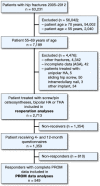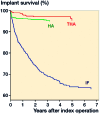High failure rate after internal fixation and beneficial outcome after arthroplasty in treatment of displaced femoral neck fractures in patients between 55 and 70 years
- PMID: 28914130
- PMCID: PMC5810833
- DOI: 10.1080/17453674.2017.1376514
High failure rate after internal fixation and beneficial outcome after arthroplasty in treatment of displaced femoral neck fractures in patients between 55 and 70 years
Abstract
Background and purpose - The treatment of patients between 55 and 70 years with displaced intracapsular femoral neck fracture remains controversial. We compared internal fixation (IF), bipolar hemiarthroplasty (HA) and total hip arthroplasty (THA) in terms of mortality, reoperations and patient-reported outcome by using data from the Norwegian Hip Fracture Register. Patients and methods - We included 2,713 patients treated between 2005 and 2012. 1,111 patients were treated with IF, 1,030 with HA and 572 patients with THA. Major reoperations (defined as re-osteosynthesis, secondary arthroplasty, exchange, or removal of prosthesis components and Girdlestone procedure), patient-reported outcome measures (satisfaction, pain, and health-related quality of life (EQ5D) after 4 and 12 months), 1-year mortality, and change in treatment methods over the study period were investigated. Results - Major reoperations occurred in 27% after IF, 3.8% after HA and 2.8% after THA. 549 patients (20% of total study population) answered both questionnaires. Compared with IF, patients treated with THA were more satisfied after 4 and 12 months, reported less pain after 4 months and 12 months, had a higher EQ5D-index score after 4 months and 12 months, and EQ-VAS score after 4 months. Compared with IF, patients treated with HA were more satisfied and reported less pain after 4 months. EQ5D-index and EQ-VAS were similar. Patients treated with HA had higher 1-year mortality and had more comorbidities than both the THA and IF group. All these differences were statistically and clinically significant. Interpretation - This study showed high reoperation rate after IF and better patient-reported outcome after both THA and HA with medium follow-up. Patients selected for HA represented a frailer group than patients treated with THA or IF.
Figures



Comment in
-
High failure rate after internal fixation and beneficial outcome after arthroplasty in treatment of displaced femoral neck fractures in patients between 55 and 70 years.Acta Orthop. 2019 Feb;90(1):94-95. doi: 10.1080/17453674.2018.1556875. Acta Orthop. 2019. PMID: 30712499 Free PMC article. No abstract available.
References
-
- Baker R P, Squires B, Gargan M F, Bannister G C.. Total hip arthroplasty and hemiarthroplasty in mobile, independent patients with a displaced intracapsular fracture of the femoral neck: A randomized, controlled trial. J Bone Joint Surg (Am) 2006: 88: 2583–9. - PubMed
-
- Bhandari M, Devereaux P J, Tornetta P 3rd, Swiontkowski M F, Berry D J, Haidukewych G, Schemitsch E H, Hanson B P, Koval K, Dirschl D, Leece P, Keel M, Petrisor B, Heetveld M, Guyatt G H.. Operative management of displaced femoral neck fractures in elderly patients: An international survey. J Bone Joint Surg (Am) 2005; 87: 2122–30. - PubMed
-
- Blomfeldt R, Törnkvist H, Ponzer S, Söderqvist A, Tidermark J.. Displaced femoral neck fracture: comparison of primary total hip replacement with secondary replacement after failed internal fixation: A 2-year follow-up of 84 patients. Acta Orthop 2006: 77 (4): 638–43. - PubMed
-
- Dai Z, Li Y, Jiang D.. Meta-analysis comparing arthroplasty with internal fixation for displaced femoral neck fracture in the elderly. J Surg Res 2011; 165 (1): 68–74. - PubMed
MeSH terms
LinkOut - more resources
Full Text Sources
Other Literature Sources
Medical
Molecular Biology Databases
Miscellaneous
